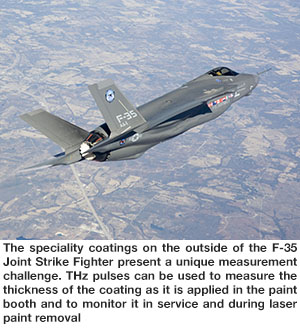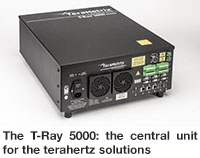State-of-the-art terahertz inspection solutions now available in the UK
05/09/2019
It is rare for NDE to welcome a whole new inspection and measurement technology but, as terahertz (THz) technology develops, THz inspection systems are now being introduced and used in NDT as a cutting-edge inspection technique, providing solutions to previously insoluble applications and measurements.Baugh & Weedon is now marketing and supporting TeraMetrix THz inspection. The company has a testing facility for samples based in St Albans and a dedicated expert available to discuss specific NDT challenges, which up until now it may not have been possible to solve with existing methodologies.
 Pulsed THz imaging can provide a range of information about a sample. It can measure the thickness of a coating as low as 10 microns, measure bonding integrity or provide highly precise multi-layer thickness measurements, all in one pass. TeraMetrix terahertz solutions can also detect the presence of internal voids, a specific gas or moisture content in consumer products and detail the density distribution in a layer of foam. Yet another application is measuring composite repair wraps where individual layers can be resolved.
Pulsed THz imaging can provide a range of information about a sample. It can measure the thickness of a coating as low as 10 microns, measure bonding integrity or provide highly precise multi-layer thickness measurements, all in one pass. TeraMetrix terahertz solutions can also detect the presence of internal voids, a specific gas or moisture content in consumer products and detail the density distribution in a layer of foam. Yet another application is measuring composite repair wraps where individual layers can be resolved.The key advantage is that THz can be used with the most advanced materials and in the most sensitive of testing environments, or where contact is not possible. Due to the low energies in use there are no associated health or safety risks to personnel or the environment. THz technology provides extremely accurate, reliable and repeatable inspection data.
Applications to date include NDT in aircraft and fibre-reinforced composites, void detection, manufacturing process and quality control, online tyre ply thickness, ceramic coating thickness measurements, inspection and repair of pipeline repair wraps, evaluation of seams and inspection of radomes and automotive fuel tanks.
In the electromagnetic spectrum, THz radiation sits between the infrared and microwave regions, with frequencies between 300-3000 GHz (0.3-3 THz) and corresponding wavelengths from 1-0.1 mm. Historically, difficulties in generating and detecting THz radiation limited research into its interactions with matter. However, recent advances now mean that it is possible to generate and detect 0.1-3 THz frequencies.
THz radiation can penetrate a wide variety of non-conducting materials, such as cardboard, plastic, ceramics, clothing, wood, masonry and paper. Penetration depth is relatively significant (although usually less than that of microwave radiation), making THz radiation suitable for probing the inner structure of samples in search of defects and inclusions.
 Many chemicals have ‘fingerprints’ that THz frequencies and THz spectroscopy can use to identify ‘objects’ of interest, for example explosives or biological agents. Using spectroscopic analysis results to generate images is a powerful application of THz. Advances in THz spectroscopic analysis have led to innovations in the following fields: threat material detection (for example explosives, weapons, etc), environmental sensing (especially gas detection) and biomedical applications (for example skin cancer detection).
Many chemicals have ‘fingerprints’ that THz frequencies and THz spectroscopy can use to identify ‘objects’ of interest, for example explosives or biological agents. Using spectroscopic analysis results to generate images is a powerful application of THz. Advances in THz spectroscopic analysis have led to innovations in the following fields: threat material detection (for example explosives, weapons, etc), environmental sensing (especially gas detection) and biomedical applications (for example skin cancer detection).The T-Ray 5000 series Control Units can be combined with the hand-held Single Point Gauge (SPG) and the Line Scan Gauge (LSG) line scanner for NDT applications.
The Single Point Gauge determines the thickness of several coating layers with unparalleled precision and the Line Scan Gauge produces images of structures under the surface. Measurements can be taken either straight on or at a right angle depending on which tip is selected. While essentially non-contact, a measurement tip helps the user to position the object at the focus of the THz beam when using a hand-held tool. The measurement configuration and mode of operation are selected using the touch-screen display. The system is capable of working on metallic or composite substrates.
For flammable environments, such as paint spray booths or coating facilities, there is an additional online sensor head (C1D1) in which the transmitter and receiver are housed within sealed stainless steel and the lens is coated with Teflon to withstand solvents. It can also be mounted on a robot. The working distance is set to 115 mm, which can be changed if needed.
Pete Burrows of Baugh & Weedon will be introducing THz NDT solutions and applications in a presentation at Materials Testing 2019 on Wednesday 4 September at 2.30 pm (Exhibition Hall 3) and attendees are invited to bring along a sample of test material, with defects, to find out more about this ground-breaking NDT technology and its capabilities.
The company will also be showcasing at Confidence in Composites 2019, 15-16 October (Oxford, UK), Advanced Engineering 2019, 30-31 October (Birmingham NEC, UK) and the ASNT Annual Conference, 18-21 November (Las Vegas, USA).
www.bw-nde.com